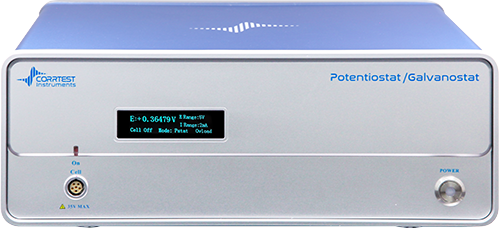CS310M Potentiostat / Galvanostat contains a fast digital function generator, high-speed data acquisition circuitry, a potentiostat and a galvanostat. With high performance in stability and accuracy with advanced hardware and well-functioned software, it is a comprehensive research platform for corrosion, batteries, electrochemical analysis, sensor, life science and environmental chemistry etc. CS310M is a cost-effective model for researchers who will need EIS, CV, LSV, galvanostatic charge & discharge, OCP, polarization curve (Tafel plot) etc. It can be used for areas of battery, corrosion, and many others. It supports earth and floating modes.

Applications
(1) Reaction mechanism of Electrosynthesis, electrodeposition (electroplating), anodic oxidation, etc.
(2) Electrochemical analysis and sensor;
(3) Corrosion study of metals in water, concrete and soil etc;
(4) Fast Evaluation of corrosion inhibitor, water stabilizer, coating and cathodic protection efficiency.
(5) New energy materials (Li-ion battery, solar cell, fuel cell, supercapacitors), advanced functional materials, photoelectronic materials;
Standard supply list for each set
Instrument host CS310M x1
CS studio software x1
Power cable x1
USB cable x1
Cell cable x2
Dummy cell(1kΩ||100µF) x1
Manual x1
Service: (**all the service is free)
1. Warranty period: 3 years
2. Provide installation guidance and manual, software installation video.
3. Lifetime free software upgrading and technical service
4. Provide repair service for free
SOFTWARE FEATURES
CS studio software provides users a versatile smoothing/differential/ integration kit, which can complete the calculation of peak height, peak area and peak potential of CV curves.
.png)
CS studio also provides powerful non-linear fitting on Butler-Volmer equation of polarization curve. It can calculate Tafel slope, corrosion current density, limitation current, polarization resistance, corrosion rate. It can also calculate the power spectrum density, noise resistance and noise spectrum resistance based on the electrochemical noise measurements.
.png)
CS Studio software can achieve real time saving of the measuring data. The data can be automatically saved even in case of sudden power off.
CS studio kit has a built-in versatile timing policy for combined measurements, which can facilitate the automation of experiments and save time.
Battery analysis: charge & discharge efficiency, capacity, specific capacitance, charge & discharge energy etc.
EIS analysis: Bode, Nyquist, Mott-Schottky plot.
.png)
TECHNICAL ADVANTAGES
1. Impedance (EIS)
CS310M potentiostat applies correlation integral algorithm and dual-channel over-sampling technique, and has strong anti-interference ability. It is suitable for EIS measurements of high-impedance system (>109Ω, such as coating, concrete etc.). It can also be used to obtain Mott-Schottky curve and differential capacitance curve. During test, the software can display real-time open circuit potential (OCP) without entering.

EIS of AA6063 Al alloy in Ce3+ containing 3% NaCl solution
2. Polarization curve
It can complete linear polarization curve and Tafel plot measurements. The user can set the anodic reversal current (passivation film breakdown current) of the cyclic polarization curve to determine material’s pitting potential and protection potential and uate the its susceptibility to intergranular corrosion. The software employs non-linear fitting to analyze polarization curve, and can make fast Evaluation of material’s anti-corrosion ability and inhibitors.
.png)
Polarization curve of Ti-based amorphous alloy & stainless steel in 3%NaCl solution
3. Voltammetry
It can do the following electroanalysis methods: Linear Sweep Voltammetry (LSV), Cyclic Voltammetry(CV).It integrates calculation of peak area, peak current and standard curve analysis.

.jpg)
LSV: mesoporous carbon material in 0.1M KOH CV of PPy supercapacitor in 0.5 mol/L H2SO4
4. Electrochemical Noise
With high-resistance follower and zero-resistance ammeter, it measures the natural potential/current fluctuations in corrosion system. It can be used to study pitting corrosion, galvanic corrosion, crevice corrosion, and stress corrosion cracking etc. Through noise spectrum, we can uate the inducement, growth and death of metastable pitting and crack. Based on calculation of noise resistance and pitting index, it can complete localized corrosion monitoring.

Electrochemical noise of low-carbon steel in 0.05mol/L Cl-+0.1mol/L NaHCO3
5. Full floating measurement
CS310M potentiostat /galvanostat uses full-floating working electrode. It can be used for autoclave electrochemical measurements, on-line corrosion monitoring of metallic components under the ground (rebar in concrete, etc.)
6. User-defined methods
CS310M potentiostat / galvanostat supports user-defined combination measurements. The user can set cyclic timing measurements of an electrochemical method or several methods.







 Contact Us
Contact Us +86 13469965984
+86 13469965984